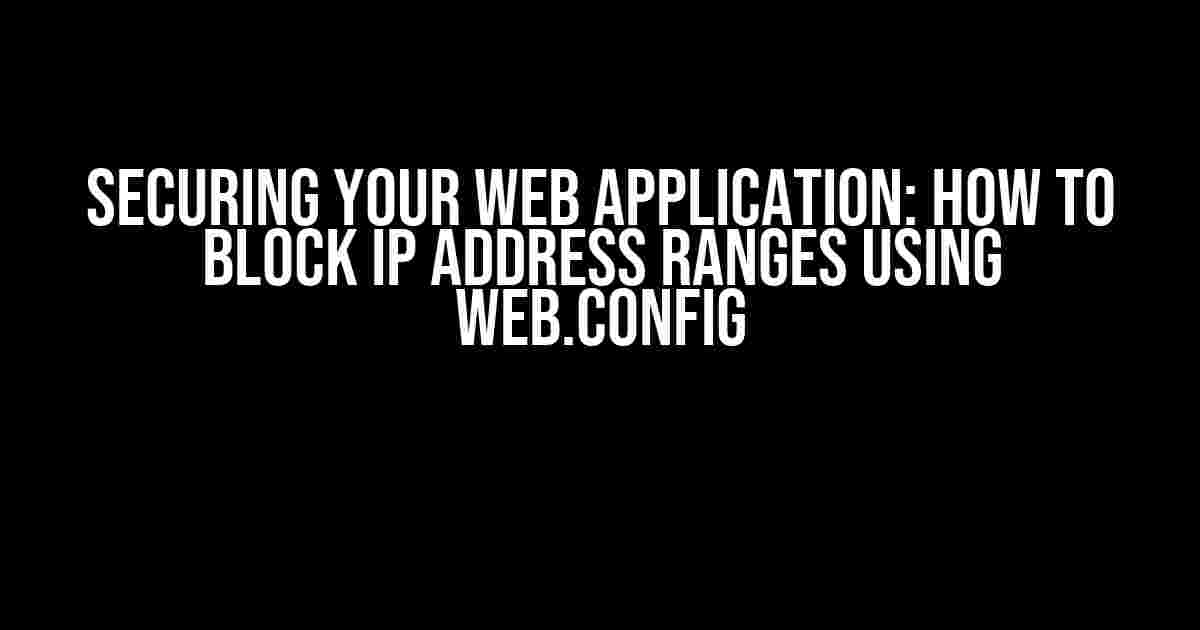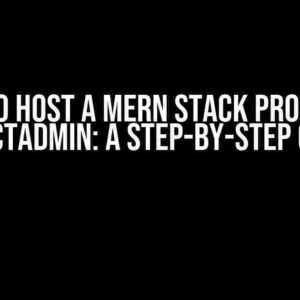As a web developer or administrator, you understand the importance of securing your web application from unauthorized access. One of the most effective ways to do this is by blocking IP address ranges that are known to be malicious or unauthorized. In this article, we’ll explore how to use the web.config file to block IP address ranges and keep your web application safe.
What is web.config?
Web.config is a configuration file used by ASP.NET web applications to store settings and configuration data. It’s an XML-based file that contains information about the application’s runtime environment, security settings, and other configuration details. One of the features of web.config is the ability to block IP address ranges, which is what we’ll focus on in this article.
Why Block IP Address Ranges?
Blocking IP address ranges is an essential security measure to prevent unauthorized access to your web application. Here are some reasons why you should consider blocking IP address ranges:
- Prevent Hacking Attempts: Hackers and cybercriminals often use specific IP address ranges to launch attacks on web applications. By blocking these IP address ranges, you can prevent hacking attempts and reduce the risk of security breaches.
- Reduce Spam and Abuse: Spammers and abusers often use specific IP address ranges to send spam requests or abuse your web application’s resources. Blocking these IP address ranges can reduce spam and abuse, improving your application’s overall performance and user experience.
- Protect Against DDoS Attacks: Distributed Denial of Service (DDoS) attacks often involve traffic from specific IP address ranges. By blocking these IP address ranges, you can protect your web application from DDoS attacks and ensure high availability.
- Improve Application Performance: By blocking IP address ranges that are known to be malicious or unauthorized, you can reduce the load on your web application and improve its overall performance.
How to Block IP Address Ranges using web.config
Now that we’ve covered the importance of blocking IP address ranges, let’s dive into the technical details of how to do it using web.config. Here are the steps to follow:
- Open the web.config File: Open the web.config file in a text editor or IDE. You can usually find this file in the root directory of your web application.
- Add the IP Address Ranges: Add the IP address ranges you want to block to the web.config file. You can do this by adding the following code snippet:
<configuration>
<system.webServer>
<security>
<ipSecurity allowUnlisted="true">
<add ipAddress="192.168.1.0" subnetMask="255.255.255.0" denied="true" />
<add ipAddress="10.0.0.0" subnetMask="255.0.0.0" denied="true" />
</ipSecurity>
</security>
</system.webServer>
</configuration>
Explanation: In the code snippet above, we’re adding two IP address ranges to be blocked: 192.168.1.0/24 and 10.0.0.0/8. The allowUnlisted="true" attribute means that all IP address ranges not listed will be allowed by default. The <add> elements specify the IP address ranges to be blocked, with the denied="true" attribute indicating that the IP address range should be blocked.
Tips and Variations:
- Block Specific IP Addresses: Instead of blocking entire IP address ranges, you can block specific IP addresses using the following code snippet:
<add ipAddress="192.168.1.100" subnetMask="255.255.255.255" denied="true" />
Block IP Address Ranges with Wildcards: You can use wildcards to block IP address ranges. For example, to block all IP addresses starting with 192.168., you can use the following code snippet:
<add ipAddress="192.168.*" subnetMask="255.255.0.0" denied="true" />
Best Practices for Blocking IP Address Ranges
Here are some best practices to keep in mind when blocking IP address ranges using web.config:
- Use Specific IP Address Ranges: Be specific when blocking IP address ranges to avoid blocking legitimate traffic. Use specific IP address ranges that are known to be malicious or unauthorized.
- Keep Your IP Block List Up-to-Date: Regularly update your IP block list to ensure that you’re blocking the latest malicious IP address ranges.
- Monitor Your Web Application’s Performance: Monitor your web application’s performance and adjust your IP block list accordingly. You may need to adjust the IP address ranges you’re blocking to prevent false positives or false negatives.
- Use Other Security Measures: Blocking IP address ranges is just one aspect of securing your web application. Use other security measures such as authentication, authorization, and encryption to protect your application.
Common Issues and Troubleshooting
Here are some common issues you may encounter when blocking IP address ranges using web.config:
| Issue | Solution |
|---|---|
| IP Address Ranges Not Blocking | Ensure that the IP address ranges are correctly formatted and that the allowUnlisted="true" attribute is set. |
| Legitimate Traffic Being Blocked | Review your IP block list and adjust it to avoid blocking legitimate traffic. Use specific IP address ranges to minimize false positives. |
| Web Application Performance Issues | Monitor your web application’s performance and adjust your IP block list accordingly. You may need to adjust the IP address ranges you’re blocking or implement other performance optimization techniques. |
Conclusion
Blocking IP address ranges using web.config is a powerful security measure to prevent unauthorized access to your web application. By following the steps and best practices outlined in this article, you can effectively block malicious IP address ranges and improve your web application’s security and performance. Remember to regularly update your IP block list and monitor your web application’s performance to ensure that you’re providing the best possible experience for your users.
Next Steps:
- Implement IP Blocking: Implement IP blocking using web.config and monitor your web application’s performance.
- Update Your IP Block List: Regularly update your IP block list to ensure that you’re blocking the latest malicious IP address ranges.
- Explore Other Security Measures: Explore other security measures such as authentication, authorization, and encryption to protect your web application.
Frequently Asked Question
Are you tired of dealing with pesky IP addresses wreaking havoc on your website? Well, wonder no more! Here are the top 5 FAQs about blocking IP address ranges in your web.config file.
Q1: What is the purpose of blocking IP address ranges in web.config?
Blocking IP address ranges in web.config helps prevent malicious traffic, such as hacking attempts, spamming, and scraping, from accessing your website. It’s an essential security measure to protect your online assets and ensure a smooth user experience.
Q2: How do I block a specific IP address range in web.config?
You can block a specific IP address range by adding the following code to your web.config file: `
Q3: Can I block multiple IP address ranges in web.config?
Yes, you can block multiple IP address ranges by adding multiple `
Q4: Will blocking IP address ranges in web.config affect my website’s performance?
Blocking IP address ranges in web.config can have a minimal impact on your website’s performance, as it only affects incoming traffic from the blocked ranges. However, if you’re blocking a large number of IP addresses, it may cause a slight delay in your website’s response time. To minimize the impact, make sure to only block IP addresses that are known to be malicious or unwanted.
Q5: Can I block IP address ranges in web.config for specific website sections only?
Yes, you can block IP address ranges in web.config for specific website sections only by adding the `




